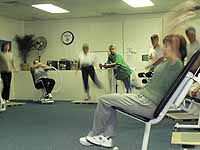According to Jennifer Eich, nutritional educator at Colorado State University, a woman’s needs can vary over her lifetime. Several factors affecting a woman’s nutritional needs include pregnancy, menstruation, breastfeeding and menopause.
A well-balanced diet usually meets a woman’s needs, however, a few key nutrients women should pay special attention to include calcium, iron, folic acid and fats, said Eich.
Women are much more likely to develop osteoporosis than men because of their smaller bone frame. Research has indicated that low calcium intake may be a major culprit, indicated Eich.
Women build the majority of their bone mass during their early years in life. Eich said that during adolescence and early adulthood, women should increase their food sources of calcium. Building maximum calcium deposits early is essential to delaying fractures that can occur later in life. Most women experience a rapid loss of bone mass in the first five years following menopause, but diet and exercise are two ways women can retain bone strength and slow age-associated bone loss.
Good sources of calcium include dairy foods (milk, cheese, yogurt), canned salmon, tofu, broccoli and leafy green vegetables, legumes (dried beans), calcium enriched grain products, and lime-processed tortillas, stated Eich.
While women need to consume more iron than men, men are more likely to eat the richest source of iron: red meat. Women may lose 15 to 20 mg of iron each month during menstruation. They’re also more likely to diet and limit the foods that help them get the minerals they need, Eich said. After menopause, body iron stores begin to increase. Therefore, iron deficiency in women over 50 years of age may indicate blood loss from another source, and should be checked by a physician.
According to Eich, animal products (i.e. meat, fish, poultry) are good sources of iron. Several plant sources, such as spinach and other green leafy vegetables, potatoes, whole grains and iron fortified cereal products also contain iron, but it’s not absorbed as well as iron from animal sources.
Absorption of iron can be increased by eating small amounts of foods containing vitamin C with the meal (e.g. citrus fruit, strawberries, green peppers, tomatoes).
Folic acid is essential for women of childbearing age. Folic acid is especially important for women trying to conceive, said Eich. Soon after conception, folate helps develop the neural tube, which becomes the baby’s spinal cord and brain. Eating sufficient folic acid protects against birth defects.
According to Eich, several good sources of folic acid include orange juice, spinach, strawberries, lentils and peanuts. In addition, many grain products, such as breads and cereals, are fortified with folic acid.
The Diet and Health Report of the National Research Council recommends reducing fat to no more than 30 percent of total calories. Saturated fat can raise blood cholesterol level. The foods with the highest amounts of saturated fat come from animals. Sources of saturated fat include meat, cream, ice cream, cheese, coconut and palm kernel oils.
The best sources of fat are from plant sources, indicated Eich. They are generally found in plant oils, nuts and seeds. To keep levels in the good range, the National Cholesterol Education Program of the National Heart, Lung and Blood Institute recommends eating no more than 300 milligrams of cholesterol a day. Cholesterol is found only in food from animal sources, such as egg yolks, dairy products, meat, poultry, shellfish and some processed products containing animal foods, although the body also naturally produces its own cholesterol.
in motion: Nutrition

